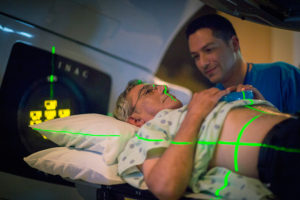 Houston Methodist Cancer Center at Sugar Land is the first in Fort Bend to offer a unique blend of technology that can significantly reduce the number of radiation treatments needed to destroy prostate cancer.
Houston Methodist Cancer Center at Sugar Land is the first in Fort Bend to offer a unique blend of technology that can significantly reduce the number of radiation treatments needed to destroy prostate cancer.
For some patients, that means effective doses of radiation can be delivered in just five treatment sessions – with reduced damage to surrounding tissue – compared with the 26 or even 44 separate sessions that other hospitals and clinics utilize.
“This is a major advancement in the treatment of prostate cancer,” said Clive Shkedy, M.D., medical director of radiation oncology services at Houston Methodist Cancer Center at Sugar Land. “Not only is it more convenient for patients, whose visits to the hospital are substantially reduced, but we are also able to be much more precise and significantly eliminate damage to surrounding tissue that can typically occur in prostate cancer radiation.”
The new approach combines the hospital’s ultra-modern TrueBeamTM linear accelerator with advancements in radiation delivery.
The first advancement is a unique hydrogel called SpaceOAR, developed by Augmenix, which is injected between the prostate and the rectum prior to the beginning of radiotherapy. The hydrogel pushes the rectum away from the prostate, protecting it from the radiation beam throughout the full course of treatment. After three months, the gel is absorbed harmlessly and passed through urination.
“Because of the proximity of the rectum to the prostate, tissue damage during radiation can occur,” said Shkedy. “Being able to separate the two, even slightly, enables us to directly target the tumor as needed while protecting the rectum and surrounding tissue.”
The second advancement is a GPS-like tracking system called Calypso™, developed by Varian, which gives the radiation oncologist a 4-D view of the prostate and allows for the greatest possible accuracy.
With the Calypso system, a urologist places three tiny transmitters in the prostate with a tool similar to a biopsy needle. The transmitters send real-time location data to a monitor in the radiation lab, allowing the radiation oncologist to see even the slightest movement of the prostate and precisely target the tumor.
“The combination of these therapies enables us to deliver a higher dose of radiation and do so more accurately,” said Shkedy. “A traditional dose has about 180-200 units of radiation per treatment; we will be able to deliver as much as 700 units of radiation per treatment in the same amount of time. And we will spare healthy tissue much more effectively.”
These technologies are supported by new guidelines from the National Comprehensive Cancer Network that call for treatment regimens of five to 26 sessions for certain patients, depending upon the stage and risk level of their specific tumor.
“Houston Methodist Cancer Center at Sugar Land is the only hospital in Fort Bend with the TrueBeam linear accelerator and the only hospital to use these technologies to improve delivery and spare healthy tissue,” said Shkedy. “This is a significant advantage for patients and one that we are pleased and proud to offer.”
Shkedy says that Houston Methodist Cancer Center at Sugar Land is already reducing the length of its radiation for other types of cancers, including lung, liver and spinal tumors.
“Depending on the stage and location of the tumor, we can successfully treat many of these cancers in five or so treatments,” said Shkedy. “It’s not something that every hospital can do as it requires advanced technology and highly skilled physicians, physicists and therapists.”
Houston Methodist Sugar Land Hospital is Fort Bend County’s only hospital with American College of Surgeons-Commission on Cancer accreditation. The Houston Methodist Cancer Center at Sugar Land treats a wide range of cancers and provides high quality, specialized services — including screenings, diagnostics, genetic testing, advanced technology, clinical trials and patient support — close to home. For more information, visit houstonmethodist.org/cancer-sl or call 281.242.CURE (2873).
